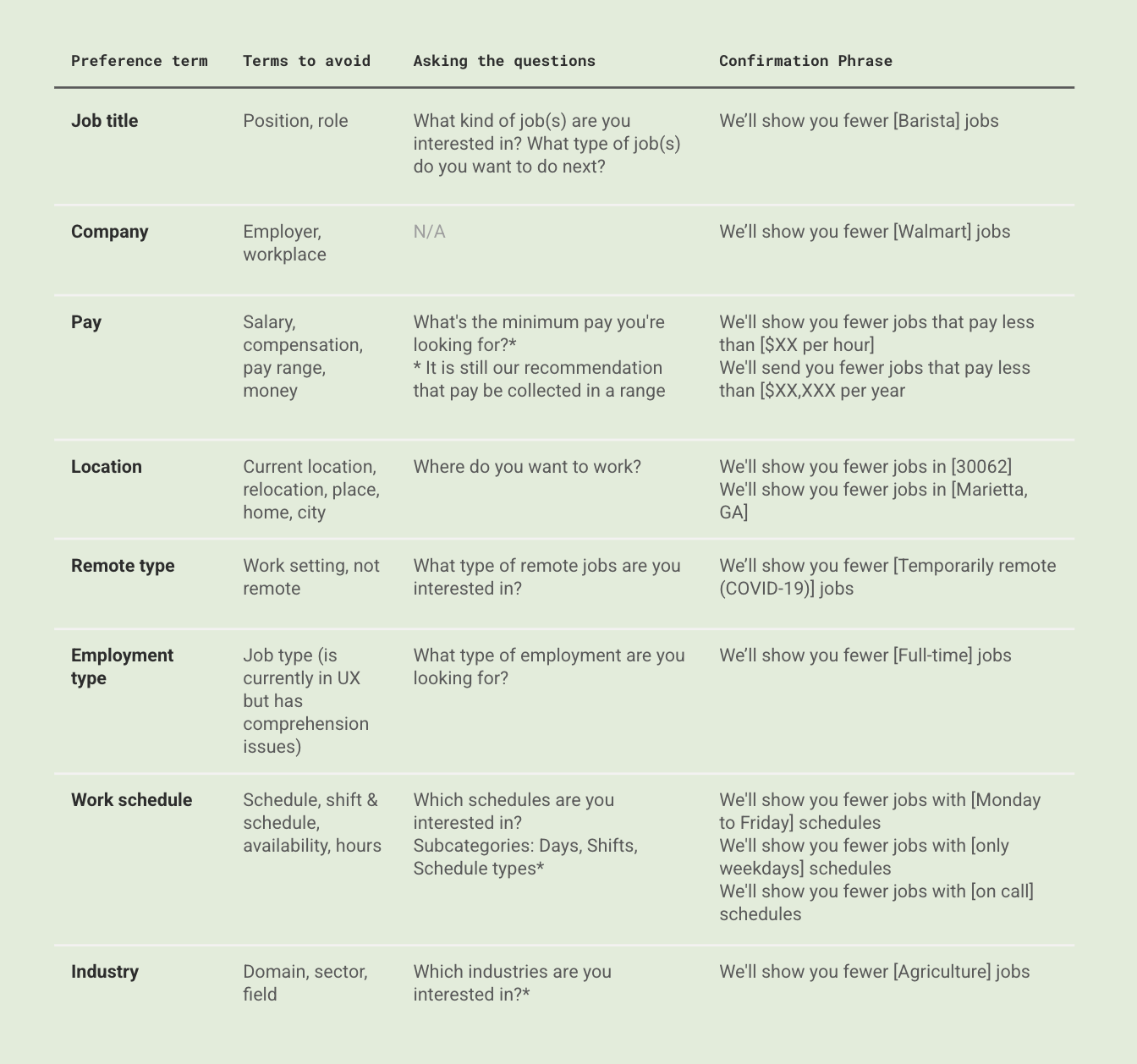
A system for collecting job preferences
Case Study | Senior UXCD | Indeed
→ UX Research
→ UX Copy
→ Content Design
→ Stakeholder Alignment
→ Design Systems
The Problem
The #1 feedback from job seekers on Indeed is that they see too many irrelevant jobs.
Indeed tried to address the issue by collecting feedback on irrelevant jobs, but each team shipped a different solution that collected different data. Not only did this create a confusing experience for users—it overloaded Indeed’s job matching engine with an incomprehensible mess of conflicting inputs.
The VP of Product asked our team to create a cohesive system for collecting job preferences that would actually improve Indeed’s job recommendations.
The Approach
We led a collaborative design sprint that used rapid experimentation to quickly align stakeholders on an MVP. Then, we turned our learnings into a global system that would work for every use case.
The MVP
Our research revealed a messy truth: job seekers’ preferences are constantly in flux. They change throughout their career, as their job search gets more urgent, and even throughout a single session.
Most people couldn’t tell us exactly what they wanted in a job—but when they saw a bad fit, they knew it immediately.
So, we focused on collecting dislikes, clear, in-the-moment feedback about what didn’t work. We tested different interaction patterns, language, and placements and tracked each experiment’s lessons in a visual timeline that helped us fast-track group consensus and launch an MVP ahead of schedule.
A clear, complete flow
Now, job seekers could get a job recommendation from Indeed, immediately state what they didn’t like about it, and know where to go to manage those inputs.
Our next sprint helped us optimize each element of this dislike collection flow to work in every context from emails to search results.
Extending the system
We ensured that preferences collected anywhere on Indeed were saved and easily managed in profile, closing the loop and letting them know they’re in control.
To build trust, we also focused on signaling to job seekers how their preferences were being used to improve their Indeed experience. That meant calling out when jobs were removed based on their dislikes, highlighting matched preferences on job pages, and providing in-context options to adjust or undo settings. Preferences weren’t just collected—they were reflected, acted on, and easy to change.
But making a cohesive UX is not enough.
To create a system that actually improves Indeed's job recommendations, we had to determine the most useful information to collect and align on how each team uses the data.
I summarized findings and led the workshop where teams determined which data points should be prioritized for collection because they improve job relevance the most.
Both the frontend UX copy and backend information (taxonomy concepts, data values and formats) were documented in the preferences lexicon.
Using content to align teams
The original solutions were made in silos, so there was no way for the data teams to learn about upstream conflicts. So, I made an inventory of preference attributes, terms used, data type collected, taxonomy concepts, and the actions each team took on preferences data (filter jobs, rank jobs, improve job matching model).
Documentation & Design Components
We created design components to help teams effectively and consistently collect preference data across Indeed.
I also used this opportunity to create the first design components with in-context content guidance. Designers appreciated this documentation so much that Indeed hired a dedicated content person to join the design system team.
Final Deliverables
We brought everything together into a shared foundation teams could build on.
A unified set of preference principles to guide product decisions
A tested, scalable pattern for collecting dislikes and positive preferences
A centralized management experience for job seekers to review and edit their preferences
Clear signaling patterns to show how preferences impact the experience
Annotated UX components and a preferences lexicon
Together, these assets gave teams across Indeed the tools to deliver a more consistent, flexible, and trustworthy preferences experience.
The Impact
The preferences system improved the user experience & increased key business metrics
Collected more accurate data
18% increase in dislike collection
5.8% increase in positive preference collection
Improved job matches
6% increase in applications for users who gave preference dislikes
4.2% reduction in I2A email related CS tickets (complaints)
9% reduction in opt-outs from I2A and other job match emails








